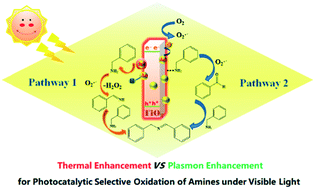Au/TiO2 nanobelts: thermal enhancement vs. plasmon enhancement for visible-light-driven photocatalytic selective oxidation of amines into imines†
Abstract
Thermo-enhanced photocatalysis has been reported as a potential strategy for improving the activity, whereas the relationship between thermal energy and the localized surface plasmon resonance (LSPR) effect of noble metal nanoparticles has been rarely investigated. Herein, photocatalytic selective aerobic oxidation of amines to imines is investigated under visible light irradiation over heterostructured TiO2(B)/anatase and Au/TiO2 nanobelts at specific temperatures (20–60 °C). The surface amine substrate complexed on TiO2 could broaden the visible-light absorption region via the ligand-to-metal charge transfer (LMCT) effect. Interestingly, the pristine TiO2 achieves the best photocatalytic performance (>99% benzylamine conversion and >99% N-benzylidenebenzylamine selectivity) at 60 °C after 12 h irradiation while the Au nanoparticles (NPs) are observed to improve the activity of TiO2 only in a low temperature range (<40 °C). Moreover, excessive Au NPs loaded on TiO2 could inhibit the amine conversion and reduce the imine selectivity in the whole temperature range of 20–60 °C, which is attributed to the decreased oxygen vacancies and poor amine adsorption ability on the surface of Au/TiO2. A plausible explanation is finally proposed that the substrate–TiO2 complex, instead of plasmonic Au NPs, plays a vital role in achieving good amine conversion and imine selectivity.



 Please wait while we load your content...
Please wait while we load your content...